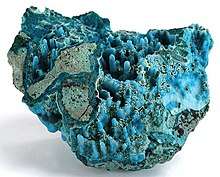Chrysocolla
| Chrysocolla | |
|---|---|
 Chrysocolla, Ray Mine, Scott Mountain area, Mineral Creek District, Pinal County, Arizona, USA | |
| General | |
| Category | Phyllosilicate mineral |
| Formula (repeating unit) | Cu2−xAlx(H2−xSi2O5)(OH)4·nH2O (x<1)[1] |
| Strunz classification | 9.ED.20 |
| Crystal system |
Orthorhombic Unknown space group |
| Unit cell |
a = 5.7 Å, b = 8.9 Å, c = 6.7 Å; Z = 1 |
| Identification | |
| Color | Blue, cyan or blue-green, green |
| Crystal habit | Massive, nodular, botryoidal |
| Cleavage | none |
| Fracture | Irregular/uneven, sub-conchoidal |
| Tenacity | Brittle to sectile |
| Mohs scale hardness | 2.5 - 3.5 ( or 7 - chrysocolla chalcedony, high silica content ) |
| Luster | Vitreous to dull |
| Streak | white to a blue-green color |
| Diaphaneity | Translucent to opaque |
| Specific gravity | 1.9 - 2.4 |
| Optical properties | Biaxial (-) |
| Refractive index | nα = 1.575 - 1.585 nβ = 1.597 nγ = 1.598 - 1.635 |
| Birefringence | δ = 0.023 - 0.050 |
| References | [2][3][1][4] |
Chrysocolla is a hydrated copper phyllosilicate mineral with formula: Cu2−xAlx(H2−xSi2O5)(OH)4·nH2O (x<1)[1] or (Cu,Al)2H2Si2O5(OH)4·nH2O.[3] The structure of the mineral has been questioned, as spectrographic studies suggest material identified as chrysocolla may be a mixture of the copper hydroxide spertiniite and chalcedony.
History
The name comes from the Ancient Greek: χρυσός κολλα (chrysos kolla), "gold glue",[5] in allusion to the name of the material used to solder gold, and was first used by Theophrastus in 315 BCE.
Geology
Chrysocolla has a cyan (blue-green) color and is a minor ore of copper, having a hardness of 2.5 to 7.0. It is of secondary origin and forms in the oxidation zones of copper ore bodies. Associated minerals are quartz, limonite, azurite, malachite, cuprite, and other secondary copper minerals. It is typically found as botryoidal or rounded masses and crusts, or vein fillings. Because of its light color, it is sometimes confused with turquoise.
Notable occurrences include Bacan Island Indonesia, Israel, Democratic Republic of Congo, Chile, Cornwall in England, and Arizona, Utah, Idaho, Colorado, New Mexico, Michigan, and Pennsylvania in the United States.
A 2006 study has produced evidence that chrysocolla may be a microscopic mixture of the copper hydroxide mineral spertiniite, amorphous silica and water.[6][1]
Jewelry
Due to being somewhat more common than turquoise, its wide availability, and vivid, beautiful blue and blue-green colors, chrysocolla has been popular for use as a gemstone for carvings and ornamental use since antiquity. It is often used in silversmithing and goldsmithing in place of turquoise and is relatively easy to work and shape. Chrysocolla exhibits a wide range of Mohs hardness ranging from 2 through 7, which is dependent on the amount of silica incorporated into the stone when it is forming. Generally, dark navy blue chrysocolla is too soft to be used in jewelry, while cyan, green, and blue green chrysocolla can have a hardness approaching 6, which is similar to turquoise. Chrysocolla Chalcedony is a heavily silicified form of chrysocolla that forms in quartz deposits and can be very hard and approach a hardness of 7.[7] [8] [9] [10]
Gallery
 Powder-blue chrysocolla as stalactitic growths and as a thin carpet in vugs inside a boulder of nearly solid tyrolite from the San Simon Mine, Iquique Province, Chile (size: 14.1 x 8.0 x 7.8 cm)
Powder-blue chrysocolla as stalactitic growths and as a thin carpet in vugs inside a boulder of nearly solid tyrolite from the San Simon Mine, Iquique Province, Chile (size: 14.1 x 8.0 x 7.8 cm) Banded white to blue green chrysocolla from Bisbee, Arizona (size: 12.2 x 5.5 x 5.2 cm)
Banded white to blue green chrysocolla from Bisbee, Arizona (size: 12.2 x 5.5 x 5.2 cm) Chrysocolla and Silver Bolo Tie. This chrysocolla specimen is from the Kennecot Copper Mine in Bingham Canyon, West Valley City, Utah
Chrysocolla and Silver Bolo Tie. This chrysocolla specimen is from the Kennecot Copper Mine in Bingham Canyon, West Valley City, Utah
See also
References
| Wikimedia Commons has media related to Chrysocolla. |
- 1 2 3 4 "Chrysocolla: Chrysocolla mineral information and data". www.mindat.org.
- ↑ "Mineralienatlas - Fossilienatlas".
- 1 2 "Handbook of Mineralogy" (PDF).
- ↑ Barthelmy, Dave. "Chrysocolla Mineral Data". webmineral.com.
- ↑

- ↑ François Farges, Karim Benzerara, Gordon E. Brown, Jr.; Chrysocolla Redefined as Spertiniite; SLAC-PUB-12232; 13th International Conference On X-Ray Absorption Fine Structure (XAFS13); July 9-14, 2006; Stanford, California
- ↑ "Gem Silica: The blue, most valuable variety of chalcedony". geology.com.
- ↑ "Chrysocolla: The gemstone chrysocolla information and pictures". www.minerals.net.
- ↑ "Chrysocolla: Multicolor Chrysocolla Gemstone & Jewelry Information - GemSelect".
- ↑ "Chrysocolla Value, Price, and Jewelry Information - IGS".